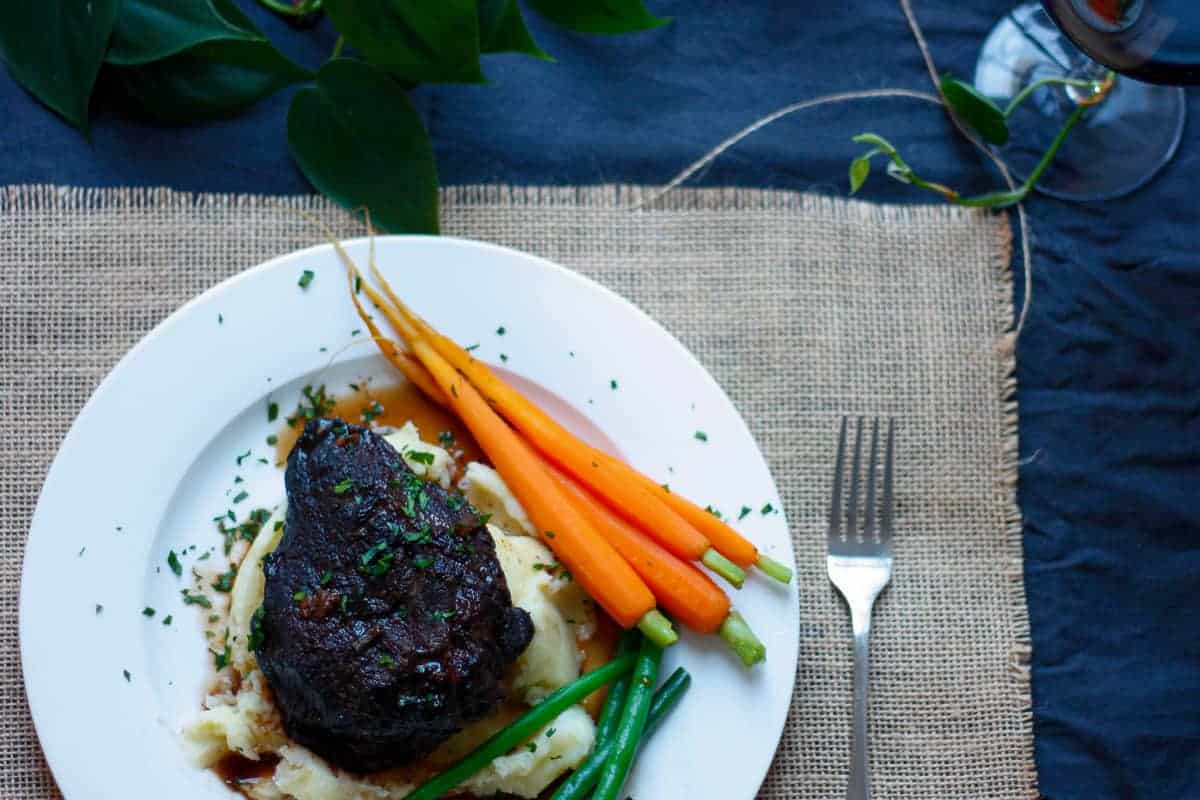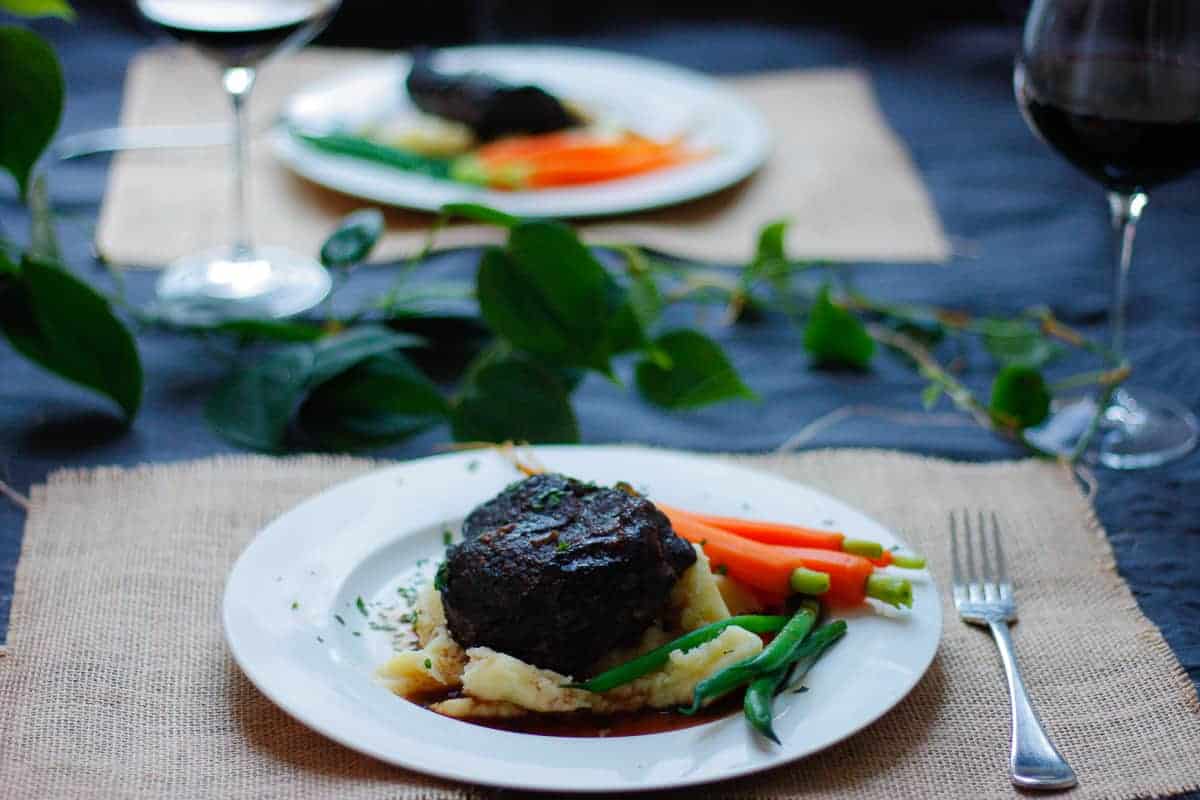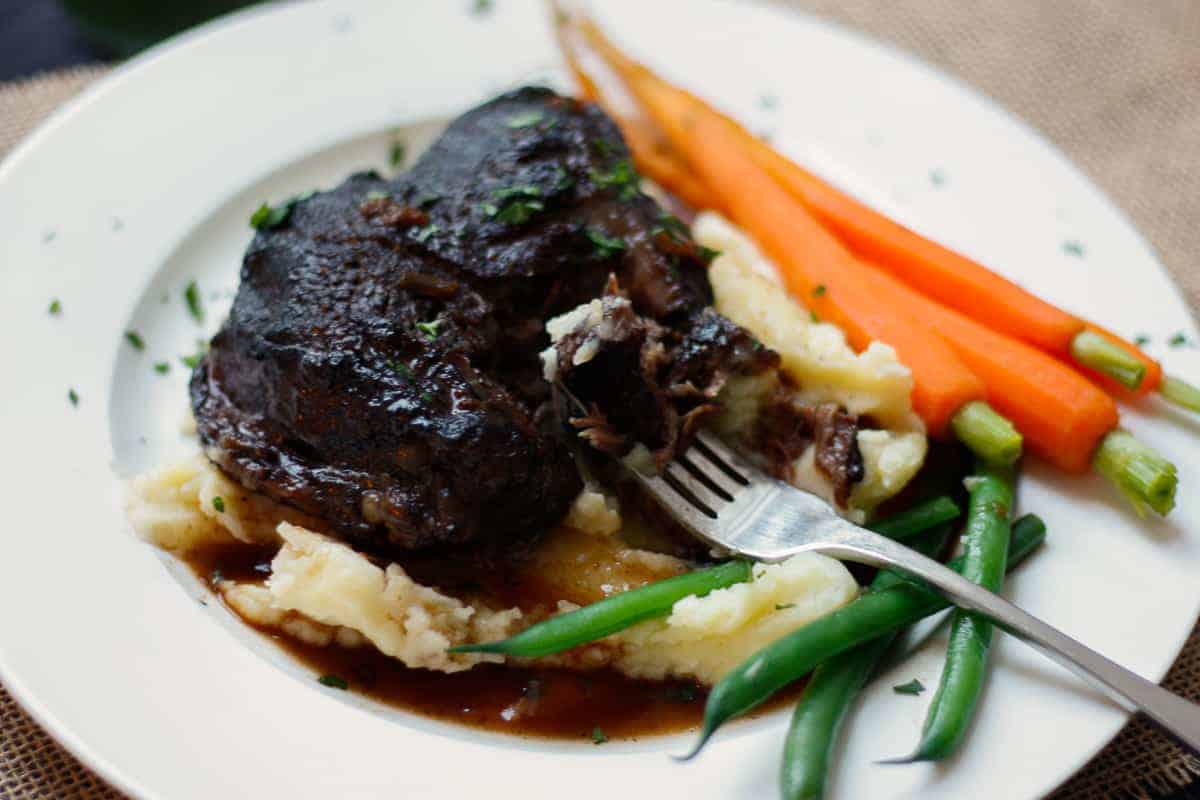Melt-in-the-mouth, fork-tender beef braised in a rich red wine sauce. Yes; beef cheeks are actual cheeks - not the bum kind, the face kind. Beef cheeks in red wine are simply delicious when cooked right. Luckily for all of us, that's very easy to do.
You could get this dish from zero to hero in around 5 hours. Or take your time and start a day or two ahead. You can cook over the weekend and reheat for dinner on a school night. Really!

The cuts of meat best suited to slow cooking are the cheaper cuts of meat. Win-win! Like lamb shanks, beef brisket and lamb shoulder. These are hard-working muscles that need low and slow cooking to make them shine.
Beef cheeks are perfect for dinner parties. Slow-cooked meat isn't complicated. It's not fancy. Beef cheeks are relatively cheap, even compared to other meats suited to slow cooking. Yet, despite all this, somehow they're special. Perhaps it's because the long cooking time requires a bit of planning? Which is a win for those in on the secret 🤫. Just bung it in a low oven for around 4 hours. No worrying about cooking it to different degrees of 'doneness' to suit everyone (steak; I'm looking at you!). It's supposed to be soft and unctuous. Meat-eaters love fall-apart slow-cooked meat!
This recipe is adapted from Gary Mehigan's 'Slow-braised Beef Cheeks with Red Onion Marmalade'. It can be found in his book 'Comfort Food'.
❓ Overview
- marinade beef cheeks with cubed vegetables in red wine & herbs for up to 24 hours. You can reduce this time if you're in a hurry.
- separate the cheeks and veg from the marinade - brown the meat, sauté the veg
- reduce the marinade to remove impurities/boil off alcohol.
- add stock to the marinade. Return the cheeks and veg to the pan. Cover well, transfer to a low oven and forget about for around 4 hours.
- serve the cheeks with the whizzed-up sauce poured over.
🥘 Ingredients
This braise has minimal ingredients - the meat is the hero.
Red Wine - gives a wonderful colour and richness. We cook off the alcohol so you can even feed it to the kids (mine love this meal!)
Thyme & Bay leaves - usual braise suspects. Aromatics for flavour. Don't use dried thyme for this; it can impart a dusty flavour.
Carrot & Celery - common flavour base for meat stews and braises. Caramelisation adds sweetness to the sauce. We blend them into the sauce at the end to add thickness and richness without needing to add flour.
Stock - flavoured and seasoned liquid to cook the meat in and bulk out our sauce. You can use stock (beef, chicken or vegetable).
💩 Are beef cheeks low FODMAP?
This recipe is Low FODMAP if the celery is limited to 40g (equivalent to 10g a portion), and the stock is low FODMAP. It is also gluten-free (if the stock is gluten free). My vegetable stock paste is low FODMAP and gluten free.
Tell me about beef cheeks
Most butchers sell these. You're less likely to find them in the supermarket. Depending how high the demand is/what season it is, they might sell them frozen. That's easy enough. Unwrap and separate them as soon as you get home and place them in the marinade. They can defrost overnight in the fridge and marinade at the same time.
I've found that beef cheeks can vary considerably in size, even from the same butcher. Smaller ones (around 200g) are perfectly portioned for one person. It's fine to slice larger ones into smaller chunks to serve though. If you can, try to find ones that are similarly sized. This can be a bit tricky if they're vacuum-packed - sometimes there's one in a pack, sometimes a pair. It can be a mystery until you open the bags. I've cooked very differently sized beef cheeks together. They've ended up still being cooked to perfection. Another bonus of slow cooking; it's very forgiving.
Dilute the stock
This recipe calls for 750ml stock. I recommend using/making up 500ml stock, then adding 250ml of plain water. If you're using my vegetable stock paste, use one Tablespoon in 750ml water (less than usual). Although we cover the meat well when we braise, it cooks for a long time. Inevitably we will lose some water and concentrate the stock. We don't want to oversalt the dish. We can always season to taste at the end.

🔪 Instructions
How to marinade
You can put the meat and its marinade in a zip lock bag. Squeeze out as much air as possible before sealing carefully and placing into a big bowl (just in case there's a leak!). If you remember, flip the bag every so often. This is easier than moving around in a big bowl. A long marinade time is not necessary. After all, the cheeks are going to be immersed in the sauce for 4 hours in the oven anyway.
How to brown beef cheeks
There's no need to bring the meat to room temperature before browning like we might with steaks. We're not cooking all the way through; we're getting some colour and flavour on the outside.
The keys to good browning (of any meat) is a dry meat surface and a very hot pan. We'll use paper towel to dry the meat until matte (not shiny)
We brown the meat in the same pan we use for braising. This retains all those wonderful flavours (and saves on washing up!). The beef cheeks will constrict and toughen up after a while over high heat. Do your best to brown them well anyway. They'll relax and soften again during the long slow braise.
Cover a braise well
We cover the meat very well before transferring to the oven. We want to keep the steam in. We don't check on the meat during the cooking time and need to keep the liquid level high enough.
One of the best things about this beef cheeks in red wine recipe is that you can make it ahead of time. It will probably taste the better for it too. Prepare it in advance and simply heat through to serve a day or two later. Stress-free entertaining.
Serve on top of a bed of creamy mashed potato or cauliflower, with some simple steamed veggies alongside.

📖 Recipe
Equipment
- Wide shallow lidded oven-proof pan big enough to take the beef cheeks in a snug single layer (about 30cm) The same pot can be used for browning and braising.
- Stick/immersion blender
Ingredients
- 1 kg beef cheeks (note)
- 2 carrots
- 40 g celery (about ½ stick)
- 500 ml red wine
- 2 fresh bay leaves
- small bunch fresh thyme (note)
- olive oil
- 750 ml stock 500ml of meat or vegetable stock made up to 750ml with plain water (note)
Instructions
- Marinade Meat - put the meat in a large zip-lock bag or bowl. Dice the (peeled) carrot and celery and add this, along with the wine, bay leaves and thyme. Ensure the meat is well covered in marinade. Transfer to the fridge for up to 24hrs, turning the meat occasionally if you remember.1 kg beef cheeks500 ml red wine2 carrots40 g celery2 fresh bay leavessmall bunch fresh thyme
- Dry Meat - remove the cheeks from the marinade (don't throw it out!) and pat them dry with paper towel. They should be dry enough that they look matte, not shiny. Pick off any veg or herbs that have stuck to them and return these to the marinade.
- Brown Meat - preheat the pan over medium then high heat. Add a tablespoon of oil to the pan and brown the cheeks well on both sides. This will take a few minutes per side. They'll thicken up but will relax after their slow cook. Once browned, remove the beef cheeks to a plate.olive oil
- Strain & Reduce Marinade - pour the reserved marinade through a sieve into the pan. Bring to a boil over high heat. Use a skimmer to remove the scummy impurities from the surface and discard. Reduce by about two thirds. Meanwhile, pick out the thyme and bay leaf from the solids in the sieve and put these in a measuring jug. Tip the celery and carrot onto some paper towel and pat dry. Once the marinade is reduced, pour it into the measuring jug with the herbs.
- Preheat Oven - to 140°C.
- Sauté Veg - reduce the heat under the pan to medium. Add a tablespoon of olive oil. Add the dried celery and carrot. Sauté for about 10 minutes until well coloured and slightly softened. You can loosen any stuck bits at the bottom of the pan with a flat-ended spatula.olive oil
- Braise - stir the stock into the marinade. Pour this over the veg. Bring to the boil over high heat. Return the cheeks to the pan. The liquid should come about ½ way up the cheeks. Add more water if this isn't the case. Carefully cover with a layer of baking paper, tucking in the edges as best as you can with a spoon like you're putting the cheeks to bed. Line the lid with foil (turn the edges upwards (towards the handle) to prevent leakage and clamp on. Transfer to the oven for 4 hours. The cheeks are ready when they yield easily when prodded. If not quite there yet, turn the cheeks, re-cover and cook for another 30 minutes, adding more plain water if necessary to come half way up the cheeks.750 ml stock
- Transfer Cheeks - carefully remove the cheeks from the marinade (they will be very soft). Transfer to a smaller baking dish in a single snug layer.
- Blend Sauce - transfer the sauce to a tall container. Pick out and discard any thyme stems and the bay leaves. Blend using a stick blender until smooth. Pour over the cheeks.










Steph K
BRILLIANT recipe - delicious, made it twice now with compliments galore from my guests. Lots of steps but easy ones - nothing too complicated. Great dinner party dish. I served with mash, creamed spinach and tenderstem broccoli.
Lisa Russo
Steph K; congratulations! You're the first 'official' visitor to my site (the one who left a genuine comment that isn't spam gobbledegook from Poland!). Thank you for your kind words. I love this recipe for a dinner party too; it seems so fancy 🤫 I forgot that it's called 'tenderstem broccoli' in the UK. It's broccolini here in Aus. Hopefully you're inspired to try some of my other recipes. Let me know how you go! 😉